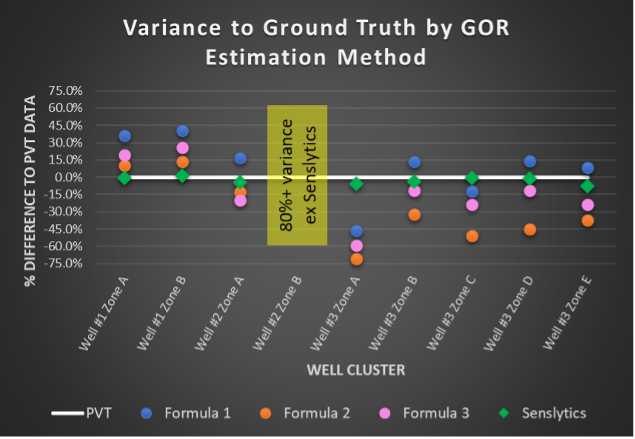Reservoir Evaluation
Problem: Estimates of gas/oil ratio (GOR), net pay, and oil typing from mudgas logs provide low levels of accuracy and are not available in real-time.
Senslytics used publicly available data from mudgas logs in the Gulf of Mexico to see how much Intuition AI could improve reservoir interpretation.
- The customer objective was to generate results within 20% of ground truth (PVT) data for GOR.
Method: Utilize limited, public data sets, domain experts, and Intuition AI to get as close to ground truth as possible.
Results: Senslytics accurately estimated gas/oil ratio (GOR) within 3% of PVT data on average, vs alternative methods which were off by at least 30%.

In Well #2 Zone B, Intuition AI generated a response that called the data “uninterpretable.” The other three formulas provided answers that were off by 80%-190% from PVT data. Because Senslytics uses a concept called ‘multi-view convergence,’ Intuition AI knows when it doesn’t have a reliable perspective to provide an interpretation. Practically, this means that in 8 of 9 tests Senslytics provided vastly improved estimates. In the 9th test, Senslytics was able to tell the customer that this well needs the attention of their subject-matter expert or advanced sampling (wireline formation testing).

Senslytics application showed value to:
- Provide earlier, reliable interpretations to estimate a wells potential and influence formation fluid sampling.
- Reduce the need for wireline operations earlier in a field’s development.
- Gain an understanding of the entire formation in a way that PVT data is not able to.
Also found that Senslytics can identify when substantial tar in the reservoir will be encountered.
Senslytics is adding capabilities to provide estimates of density, API gravity, and other factors.
Senslytics’ AI platform could be used for multiple related applications where data obtained has historically been considered low value.
